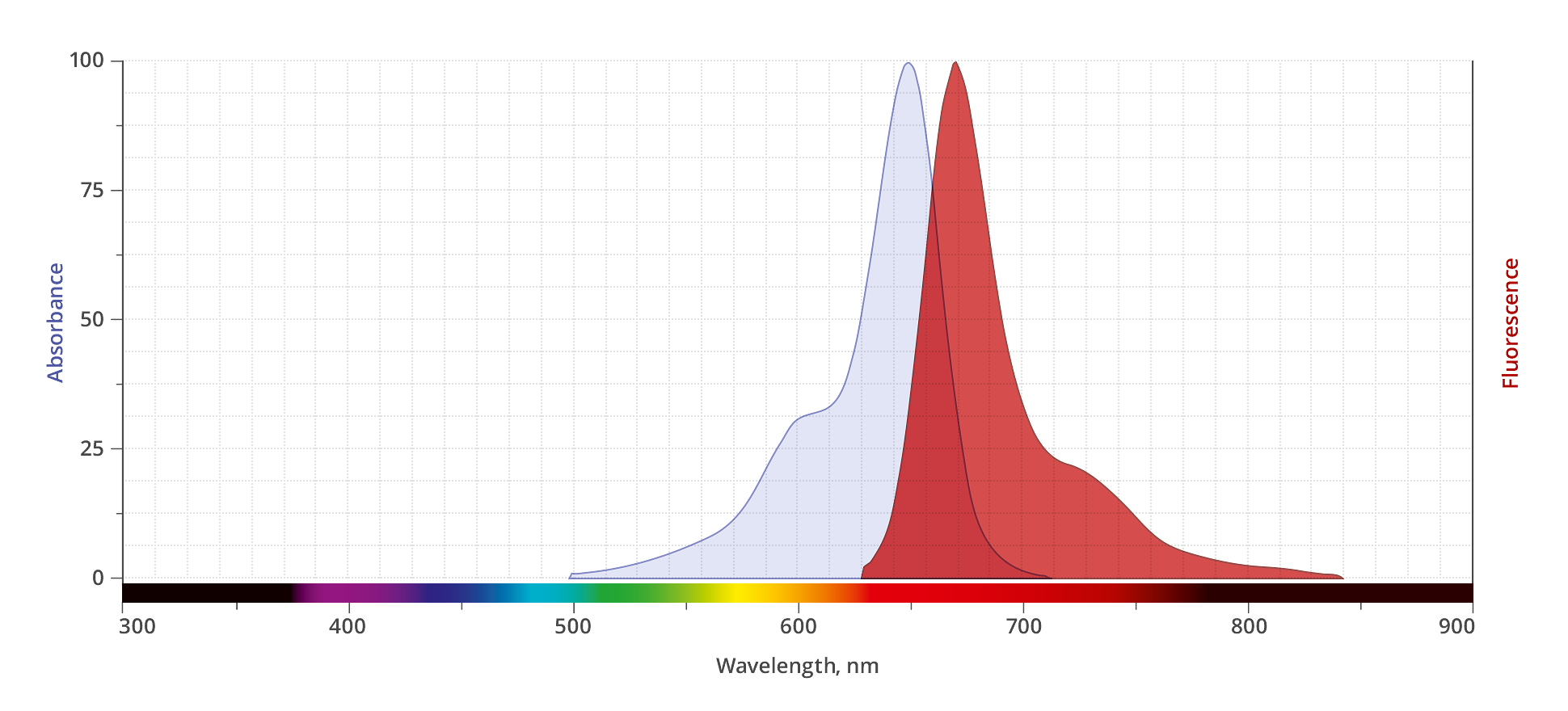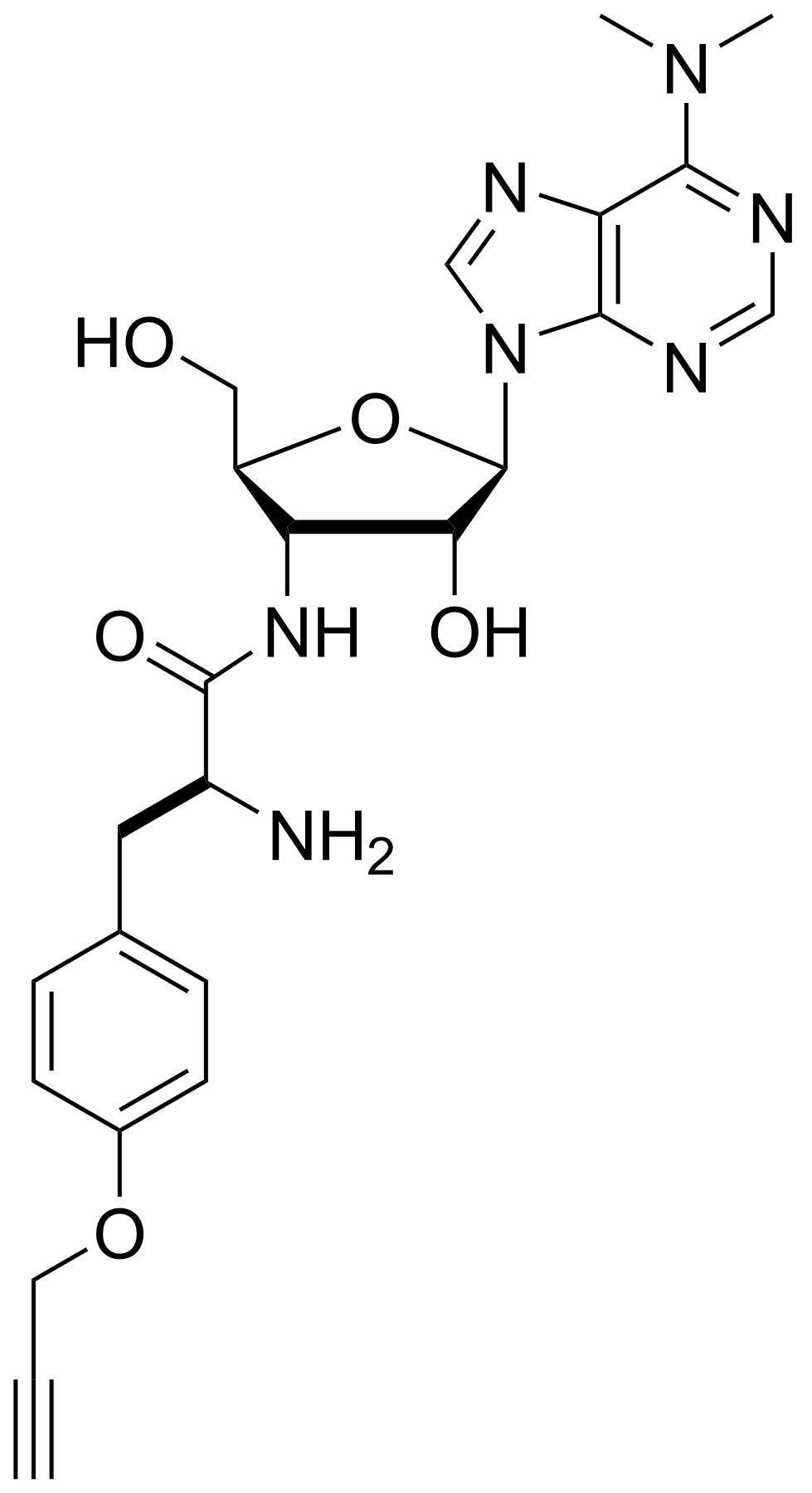Click-&-Go Plus 647 OPP Protein Synthesis Assay Kit
Click-&-Go? Plus 647 OPP Protein Synthesis Assay Kit is a non-radioactive method for measuring protein synthesis that employs the cell-permeable, alkyne-containing, puromycin analog O-Propargyl-puromycin (OPP). OPP (O-propargyl-puromycin) is an analog of puromycin that contains a terminal alkyne group, enters the acceptor site of ribosomes and incorporates into the C-terminus of translating polypeptide chains, thereby stopping translation. These truncated C-terminal alkyne-labeled proteins are then subsequently detected via copper-catalyzed click reaction using far-red fluorescent AZDye 647 Azide Plus. Unlike HPG or AHA labeling reagents OPP is not an amino acid analog; thus, OPP can be added directly to cells in complete media (i.e., methionine-containing) or used to detect in vivo protein synthesis. The kit contains all of the components needed to label and detect the incorporated OPP in newly translated proteins in samples of adherent cells. The kit includes sufficient reagents for the labeling of 25 18 mm × 18 mm coverslips using 1 mL of reaction buffer per test.
Synthesis of many proteins is tightly controlled at the level of translation, and plays an essential role in fundamental processes such as cell growth and proliferation, signaling, differentiation, or death. Methods that allow imaging and identification of nascent proteins are critical for dissecting regulation of translation, both spatially and temporally, particularly in whole organisms. Although protein synthesis is a conserved and essential cellular function, it is often regulated in a cell-type-specific manner to influence cell fate, growth and homeostasis. Most methods used to measure protein synthesis depend on metabolically labeling large numbers of cells with radiolabeled amino acids, stable isotope-labeled amino acids, bioorthogonal noncanonical amino acid tagging (L-azidohomoalanine or homopropargylglycine or their combination). Because these methods typically depend on specialized growth conditions, they have been largely restricted to yeast, bacteria and cell lines. Application of these techniques for investigating protein synthesis within mammalian systems in vivo has been challenging.
The use of O-propargyl-puromycin (OPP), an analog of puromycin that contains a terminal alkyne group, has facilitated the quantification of protein synthesis within individual cells in vivo. OPP enters the acceptor site of ribosomes and incorporates into nascent polypeptide chains. Unlike traditional methods mentioned above, OPP is not an amino acid analog; thus, OPP can be added directly to cells in complete media (i.e., methionine-containing) or used to detect in vivo protein synthesis. It also can be used with cell lines that are sensitive to media exchanges or incubation in methionine-free media. The combination of high cell permeability and signal-to-noise ratio makes OPP an ideal candidate compound to study nascent proteomes across a wide array of cellular types and conditions. The kit contains all of the components needed to detect incorporated OPP with far-red-fluorescent AZDye 647 Azide Plus (Alexa Fluor? 647 equivalent), and blue-fluorescent Hoechst 33342 dye for nuclear staining. A sufficient amount of reagents is provided for imaging 25 coverslips or 250 wells using 96-well plates.


Abs/Em Maxima: 346/445 nmExtinction Coefficient: 19,000Spectrally Similar Dyes: Alexa Fluor? 350, CF? 350, DyLight 350, AMCAAZDye? 350 is a blue-fluorescent azide-activated probe that reacts with terminal alkynes via a copper-catalyzed click react…
Abs/Em Maxima: 402/424 nmExtinction Coefficient: 35,000Flow Cytometry Laser Line: 405 nmMicroscopy Laser Line: 405 nmSpectrally Similar Dyes: Alexa Fluor? 405, CF? 405, Cascade Blue?, DyLight? 405AZDye? 405 Azide is a water-soluble, pH-insensiti…
Abs/Em Maxima: 346/445 nmExtinction Coefficient: 19,000Spectrally Similar Dyes: Alexa Fluor? 350, CF? 350, DyLight 350, AMCAAZDye? 350 Alkyne (Alexa Fluor? 350 Alkyne equivalent) is a blue-fluorescent, alkyne-activated probe that reacts with azid…
Abs/Em Maxima: 430/537 nmExtinction Coefficient: 15,000Spectrally Similar Dyes: Alexa Fluor? 430, CF? 430AZDye? 430 Azide is a water-soluble, green-fluorescent azide-activated probe that reacts with terminal alkynes via a copper-catalyzed click re…
Abs/Em Maxima: 346/445 nmExtinction Coefficient: 19,000Spectrally Similar Dyes: Alexa Fluor? 350, CF? 350, DyLight 350, AMCAAZDye? 350 DBCO reacts with azides via a copper-free “click chemistry” reaction to form a stable triazole and does not re…
Abs/Em Maxima: 402/424 nmExtinction Coefficient: 35,000Flow Cytometry Laser Line: 405 nmMicroscopy Laser Line: 405 nmSpectrally Similar Dyes: Alexa Fluor? 405, CF? 405, Cascade Blue?, DyLight? 405AZDye? 405 Alkyne reacts with azides via a copper…
Abs/Em Maxima: 494/517 nmExtinction Coefficient: 73.000Flow Cytometry Laser Line: 488 nmMicroscopy Laser Line: 488 nmSpectrally Similar Dyes: Fluorescein, Alexa Fluor? 488, CF? 488A, DyLight? 488, Atto? 488AZDye? 488 Azide (Alexa Fluor? 488 Azi…
Abs/Em Maxima: 402/424 nmExtinction Coefficient: 35,000Flow Cytometry Laser Line: 405 nmMicroscopy Laser Line: 405 nmSpectrally Similar Dyes: Alexa Fluor? 405, CF? 405, Cascade Blue?, DyLight? 405ZDye? 405 DBCO reacts with azides via a copper-fr…
